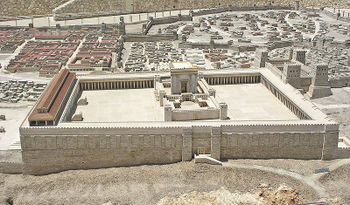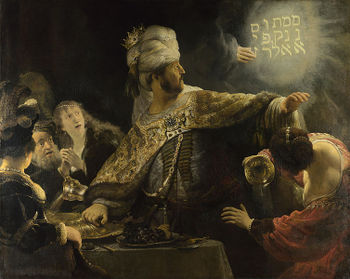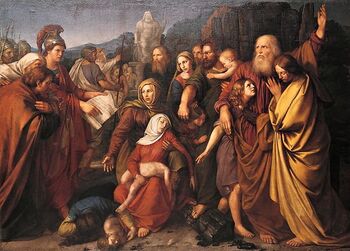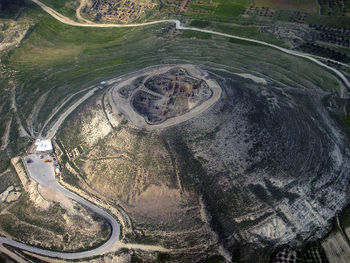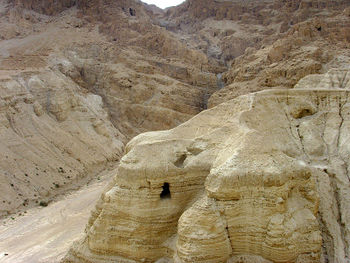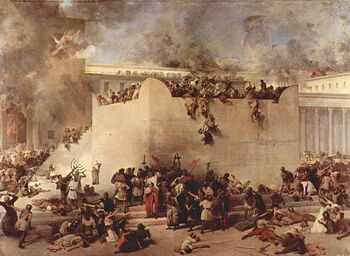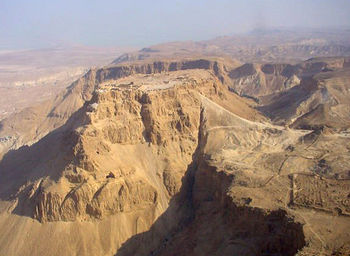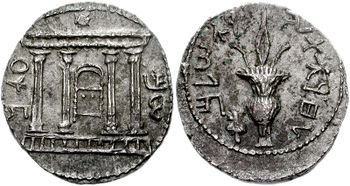History and Religion of Second Temple Judaism (2015 Boccaccini), course
History and Religion of Second Temple Judaism is a course offered by Gabriele Boccaccini at the University of Michigan.
Description
The seminar covers the history and religion of Second Temple Judaism, from the Babylonian exile (6th cent. BCE to the emergence of Rabbinic Judaism (3rd cent CE). It was an age of great conflicts, in which the Jews had to face powerful neighbors and rulers: The Egyptians and the Babylonians, the Persians, the Greeks, and the Romans. It was also an age of great creativeness, in which different varieties of Judaism (including the early Christian movement) developed sophisticated and lasting theologies and restlessly struggled for supremacy or survival.
The focus is on reading of primary sources in the original text (or English translation), within a methodological approach that frees the documents from the cages of their denominational corpora and restores their original links, as representatives of competing forms of Judaism.
Grading is based on daily reading assignment, participation to discussion, and a final research paper.
Textbooks and Essential Bibliography
Source-texts:
The New Revised Standard Version Bible with the Apocrypha (New York: Oxford University Press, Press, 1989) F. Garcia Martinez, and E.J.C Tigchelaar (eds.), The Dead Sea Scrolls: Study Edition, 2 vols. (Leiden: Brill, 1997). J.H. Charlesworth (ed.), The Old Testament Pseudepigrapha (New York: Doubleday, 1983-85) L.H. Schiffman, Texts and Traditions: A Source Reader for the Studyof Second Temple and Rabbinic Judaism (Hoboken: Ktav, 1998)
Textbooks:
G. Boccaccini, Roots of Rabbinic Judaism: An Intellectual History, from Ezekiel to Daniel (Eerdmans: Gran Rapids, 2002) G. Boccaccini, Beyond the Essene Hypothesis: The Parting of the Ways between Qumran and Enochic Judaism (Eerdmans: Grand Rapids, 1998) L.L. Grabbe, An Introduction to Second Temple Judaism: Jewish Religion and History in the Second Temple Period (Edinburgh: T&T Clark, 1996). T. Ilan, Integrating Jewish Women into Second Temple History (Tübingen: Mohr Siebeck, 1999
Additional Readings:
- G. Boccaccini, Middle Judaism, Jewish Thought, 300 BCE to 200 CE (Minneapolis: Fortress, 1991)
- G. Boccaccini, Portraits of Middle Judaism in Scholarship and Arts (Turin: Zamorani, 1992)
- J.J. Collins, The Apocalyptic Imagination: An Introduction to Jewish Apocalyptic Literature (Grand Rapids: Eerdmans, 1998)
- J.J. Collins and D.C. Harlow, The Eerdmans Dictionary of Early Judaism (Grand Rapid: Eerdmans, 2010)
- S.J.D. Cohen, From the Maccabees to the Mishnah (Philadelphia: Westminster, 1987)
- S.J.D. Cohen, The Beginnings of Jewishness: Boundaries, Varieties, Uncertainties (Berkeley: University of California, 1999)
- L.L. Grabbe, Judaism from Cyrus to Hadrian, 2 vols. (Minneapolis: Fortress, 1992)
- L.L. Grabbe, Judaic Religion in the Second Temple Period (London: Routledge, 2000)
- M. S. Jaffee, Early Judaism (Upper Saddle River: Prentice-Hall, 1997)
- J. Neusner, The Four Stages of Rabbinic Judaism (London: Routledge, 1999)
- P. Sacchi, The History of the Second Temple Period (Sheffield: Sheffield Academic, 2000)
- E.P. Sanders, Judaism: Practice and Belief, 63 BCE – 66 CE (Philadelphia: Trinity, 1992)
- L.H. Schiffman, From Text and Traditions: A History of Second Temple and Rabbinic Judaism (Hoboken, Ktav, 1991)
Schedule
Introduction to Second Temple Judaism
- (a) From Judaism to Judaisms: The History of Research, from Josephus to the present
- (b) Four Contemporary Approaches (Sanders, Schiffman, Cohen, Grabbe)
Part 1 -- The Babylonian Exile
- (c) From Polytheism to Monotheism (Kings, Deutero-Isaiah)
- (d) The Rise of the House of Zadok (Ezekiel 40-48)
Part 2 -- The Restoration
- (a) Sheshbazzar, Zerubbabel and the End of the House of David
- (b) Sons of Levi, Sons of Aaron, Sons of Phineas: The New Structure of the Jerusalem Priesthood
- (c) Nehemia and Ezra: Their Mission and Their Opponents (Prophets, Tobiads, Samaritans)
- (d) The Zadokite Wordview (Priestly Writing, Chronicles)
Part 3 -- Political and Religious Paries that Shaped the Hebrew Bible
- (a) The Priestly Opposition: Enochic Judaism (Book of the Watchers)
- (b) The Zadokite and Enochic Sabbatical Calendars (Book of Astronomy)
- (c) The Lay Opposition: Sapiential Judaism (Akiqar, Proverbs, Job, Jonah)
- (d) The Early Ptolemaic Period and the Clash between Zadokite and Sapiential Judaism (Qohelet)
Part 4 -- The Rapprochment between Zadokite and Sapiential Judaism
- (a) The Late Ptolemaic Period (Septuagint, Artapanus, Tobit)
- (b) The Early Seleucid Period: The Golden Age of Zadokite Priesthood (Sirach)
Part 5 -- The Maccabean Revolt
- (c) The End of the Zadokite Power: Hellenists and Anti-Hellenists
- (d) Maccabees, Enochians (Dream Visions) and Sadducees (Baruch)
Part 6 -- In the Aftermath of the Maccabean Revolt
- (a) A Third Way between Zadokite and Enochic Judaism (Daniel)
- (b) The Hasmonean Rule (1 Maccabees, Judith) and the Pharisaic Opposition (2 Maccabees)
- (c) The Essenes and Qumran Origins: The Evidence of the Qumran Library
- (d) Developments and Hopes of the Enochic Movement (Jubilees, 1QT)
Part 7 -- The Parting of the Ways between Qumran and Enochic Judaism
- (a) From Enochians to Essenes (Proto-epistle, 4QMMT)
- (b) From Essenes to Qumranites (Damascus Document)
- (c) The Sectarian Worldview (Community Rule, War Scroll)
- (d) Enoch vs. Qumran (Epistle of Enoch, Testaments of the Twelve Patriarchs)
Part 8 -- Hellenistic Judaism
- (a) The Early Period (Aristobulus and Aristeas)
- (b) Judaism as the Religion of the World (Philo of Alexandria)
Part 9 -- The Rise of Messianism
- (c) The Sadducean Messiahs and the Pharisaic “Son of David” (Psalms of Solomon)
- (d) The Qumran Messiahs and the Enochic “Son of Man” (Similitudes of Enoch)
Part 10 -- Christian Origins
- (a) The Problem of Christian Origins (from the Recognition of the Jewishness of Jesus to the Identification of His Sectarian Identity)
- (b) John the Baptist (Life of Adam and Eve)
- (c) The Life and Teaching of Jesus the Essene (Mark)
- (d) Christianity as an Early Jewish Sect (James and Paul)
Part 11 -- The Destruction of the Temple
- (a) The Jewish War and the Destruction of the Temple
- (b) Essene Responses: From Hope to Despair (Apocalypse of Abraham, 4 Ezra)
- (c) Christian Responses: The Development of the Logos Christology and the Separation from Jerusalem (Matthew, Luke, John, Revelation)
- (d) Proto-Rabbinic Responses: The Centrality of the Torah and of the Mosaic Covenant against the Heresy of the “Two Powers in Heaven” (Pseudo-Philo, 2 Baruc)
Part 12 -- The Parting of the Ways between Christianity and Rabbinic Judaism
- (a) The Bar-Kokhba Revolt and Its Aftermath
- (b) The Theology of Supercession (Justin)
- (c) The Rise of Rabbinic Judaism (Neophiti, Mishnah, Aboth, Tosefta)
- (d) Conclusion: Rabbinic Judaism and Christianity as Fraternal Twins
Special Topic
Every year, the course will focus on a particular topic: the Enochic Tradition (in 2015), the Essenes and the Dead Sea Scrolls (in 2016), etc.
